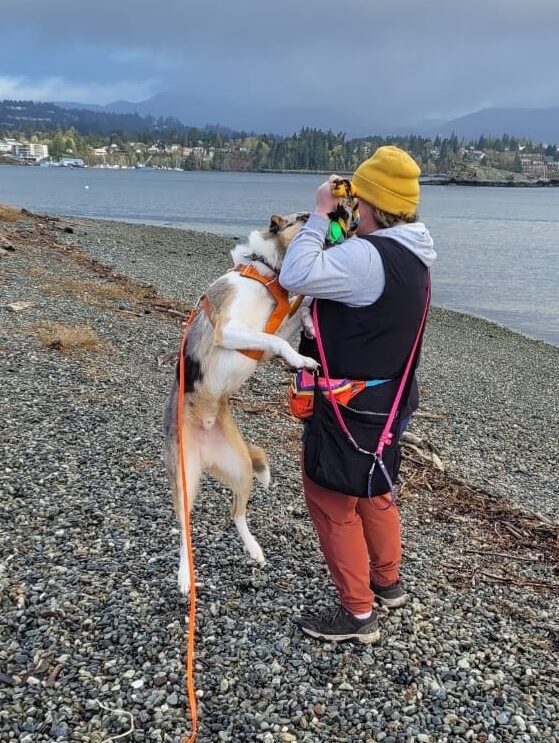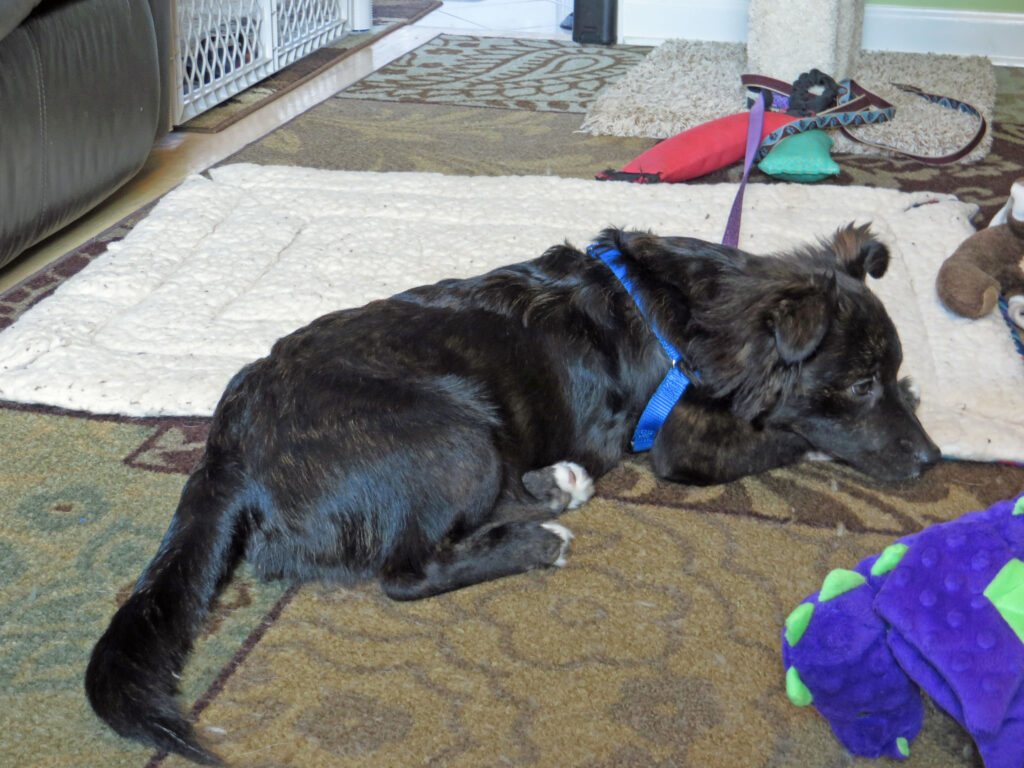
Petting initiated, attention seeking, and arousal driven mouthiness in adult and adolescent dogs is an annoying and often painful problem! But thankfully there’s a lot that we can do to help!
I had a dog staying with me once years ago who was an excellent case study for one way that I addressed a dog who had some arousal-based bitey and mouthy troubles along with some other arousal based challenges going on.
Jax* was an approximately 1 year old female mix who had been with me for about two weeks. Jax’s history was unknown but she came out of a shelter as an adolescent. She came to stay with me for a bit when her family was away.
The first few days with Jax were rough. Really rough. She was stressed to the max with life changes and was having a very hard time (and because she was having a hard time, I was too). She barked in her crate when there were times of transition (when all reports prior indicated she was pretty quiet when crated), she was a totally frenzied maniac when out of her crate and including zoomies while body slamming me and grabbing at me, she had no concept of boundaries (personal or with regards to things), and I could not even begin to touch her without her getting overstimulated and mouthing/biting at my hands in excitement (never hard).
It was not a very pleasant first couple days but with a consistent plan and a natural decline in stress hormones as she settled in, huge progress was made within the first 7 days of her being with me.

Overall, Jax’s primary issues were…
1. Mouthy/bitey when being touched, when aroused (during play and sometimes on walks), and when attention seeking
2. No understanding of personal boundaries
3. Inability to settle outside of her crate.
Although the bitey/mouthy was the biggest issue, it’s actually NOT the issue I tackled. I was very certain that by fixing the other issues going on that the bitey/mouthy things would actually be resolved. This is something I’ve seen with countless dogs struggling with bitey, mouthy, grabby, over arousal challenges–they are just symptoms of a system out of whack.
So what was our plan of attack?
As with most of my training plans, it was all about environmental management, differential reinforcement of alternative behaviors, and addressing the needs/drives of the dog (including enrichment, exercise, and sleep)
My training protocol the first few days was pretty much to reward anything that wasn’t mouthy, bitey, amped up, or climbing on me. Really, I wasn’t even working on any skills the first few days just stillness or space bubble in some way shape or form.
For her, “better than bad” behavior was something like this: Oh good, you are standing on the ground and not bouncing off the couch, here’s a piece of food… oh fantastic, you stood still after you swallowed that last piece of food, here’s another, oh good, you are still standing still after eating that last piece, here’s another… oh, you were on the couch and sat when asked to, here’s food on the opposite end of the couch on your reward mat (to get her to not climb ON me), you are still on that side of the couch, here’s another piece on your mat… oh you are chewing a toy, here’s a piece of kibble…etc.
For environmental management we used crates, gates, tethers, location specific reinforcer procedures (not marker signals). We implemented a predictable schedule and routine for her with patterns that did not include lots of high arousal things happening when she got out of the crate most of the time.
I also implemented real management regarding the bitey mouthy challenges. Unless I was leashing her up, putting her collar on/off, I simply did not touch her. Every time I touched her she would bite at me and get over aroused and start zooming with biting at me. So I used food every time I put her collar on or off, grabbed her collar, or leashed her up–I would either do a scatter or smear of peanut butter so she could eat while i handled her. Lastly, I withheld almost all affection unless she asked nicely–I had a sneaking suspicion that she was just being handled a lot and it was over stimulating her.
My initial plan also included a change of the exercise she had been getting at her home. She would ultimately be getting less amped up exercise at my house and overall probably less exercise (the answer was never more exercise, it was more sleep, more enrichment, and more thoughtful exercise). Our exercise was thoughtful–a sniffy walk, one free-running/play yard session each day with a doggo friend, kibble dispensing balls for her meals, and destruction enrichment. Until we’d made a little progress on the aforementioned “please for the love of all things good just stop moving and stop crawling in my skin” training, this was our plan. Once we got some breathing room, we added in training sessions that were sometimes physically challenging for her.
So what did her day look like?
When she came out of her crate in the morning, she got a potty break free in the yard and would have half of her breakfast in a puzzle ball to roll around and chase. After her part of breakfast, she would get a 15-20min sniffy walk (not decompression, just in the neighborhood but she could sniff and explore). Once we got back I would use the other half of her breakfast for rewarding “better than bad” behavior.
After her breakfast was totally finished she was put in her crate with a chew item for a nap for several hours.

Basically that routine was repeated several times throughout the day, swapping feeding for a different activity. We did lots of scavenging for snacks in the yard and we did a lot of destruction enrichment for her to chew and shred. By the second week we’d built enough stillness that I could safely implement a tether on a mat/bed to help her settle some place not near me. I don’t use tethers all the time and definitely not for every dog, but for this dog, after some initial work, it was very helpful.
While exercise was an important part of the puzzle, I did not want to encourage more arousal for this dog, so instead of fetch or flirt pole, she got sniffy walks, kibble scatters in the yard to spend lots of time moving around outside, and some neighborhood walks. My emphasis was more on teaching a settle than trying to exercise her into calmness because that 1. isn’t sustainable for most owners 2. doesn’t fix our real problem 3. just builds up her stamina to need more and more.
It wasn’t rocket science, but it was hard work. It took diligence and a commitment to this routine, protocol, and management plan to see improvements but over the days she offered more and more relaxed behavior outside of the crate and less obnoxious bitey behavior in general.
She was never out of the crate without a plan or activity to ensure she was practicing appropriate behavior. If I couldn’t work with her or occupy her with a puzzle, toy, or activity, she was crated–it’s not often that I micromanage dogs, but for this dog it was necessary to establish new habits and routines. It was this strict adherence to my plan that allowed her to be successful
Outcomes

The first few days she was crated a good bit, but those few days of crating allowed us to make the progress needed to quickly get her making better choices outside the crate by preventing unwanted behavior and giving us a ton of things we could reward.
By the end of her 2-week stay with me she could lay on the couch for a couple hours with only sporadic pieces of kibble (and she’d get off the couch and go chew a toy for a while or move to the floor to hang out). While I was still not doing a lot of petting or touching, I could get her collar and leash on/off with minimal drama. When I did get her revved up by doing some toy play near the end of that second week, she never flipped a switch into wild lunging and biting zoomies. We also didn’t have many episodes of her getting crazy on the leash becasue she had already had some outside time, some mental/physical stimulation, and our walk was on a long-line where she could sniff and explore.
By addressing other arousal issues, the bitey mouthy problems, which were symptoms of the problem, become significantly less problematic. So we worked to fix two of three issues and then got the third one for free! She went back to her home and they implemented the routine that I had put in place and she was significantly better. Very few episodes of becoming bitey or mouthy and while it was a work in progress, she was more successful settling in general.
